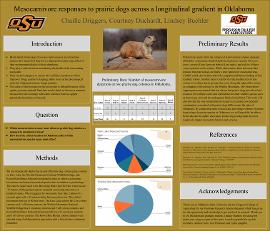| dc.contributor.advisor | Duchardt, Courtney | |
| dc.contributor.author | Driggers, Chaille | |
| dc.contributor.author | Buehler, Lindsey | |
| dc.date.accessioned | 2022-04-14T20:11:10Z | |
| dc.date.available | 2022-04-14T20:11:10Z | |
| dc.date.issued | 2022-04-19 | |
| dc.identifier | oksd_URS_2022_driggers | |
| dc.identifier.citation | Driggers, C., Duchardt, C., & Buehler, L. (2022, April 19). Mesocarnivore responses to prairie dogs across a longitudinal gradient in Oklahoma. Poster session presented at the Oklahoma State University Undergraduate Research Symposium, Stillwater, OK. | |
| dc.identifier.uri | https://hdl.handle.net/11244/335240 | |
| dc.description.abstract | Black-tailed prairie dogs (Cynomys ludovicianus) are a keystone species; this means that they have a disproportionately large effect on their environment relative to their abundance. They play a critical role in maintaining the health of the surrounding ecosystem. They eat and clip grass to ensure the visibility of predators which improves forage quality by keeping plants in an earlier phenological state, but clipping decreases forage quantity. The value of their presence in the ecosystem is debated because of the quality-quantity tradeoff. Ranchers tend to think of them as a nuisance because their diet overlaps with cattle and their burrows appear potentially hazardous to livestock. We have strategically placed on and off prairie dog colony game cameras on Kaw Lake, the Wichita Mountains National Wildlife Refuge, and Kiowa/Rita Blanca National Grassland in order to observe ecosystem interactions and record associated species data in relation to prairie dogs. Preliminary results from the cameras at Kaw lake have shown opossum (Didelphis virginiana), skunk (Mephista mephista), raccoon (Procyon lotor), coyote (Canis lantran) bobcat (Lynx rufus), red fox (Vulpes vulpes), and white-tailed deer (Odocoileus virginianus) present on the colony. While observations from this early data indicate that prairie dogs are likely a prey species for mesocarnivores, wildlife could also be attracted to the supplemental human feeding of this roadside colony. Our observations support previous research that has shown that prairie dogs provide a food resource for multiple carnivores and habitat for other wildlife species such as burrowing owls and the endangered black-footed ferret. This work will also provide the only comprehensive dataset to examine how predator communities associated with prairie dogs differ across the state of Oklahoma. By conducting more research and providing evidence of prairie dogs being a keystone species in Oklahoma, we will hopefully be able to better educate the public and ensure prairie dog management does not negatively impact ecosystem function and services. | |
| dc.description.sponsorship | Oklahoma State University. Freshman Research Scholars Program | |
| dc.format | application/pdf | |
| dc.language | en_US | |
| dc.publisher | Oklahoma State University | |
| dc.rights | In the Oklahoma State University Library's institutional repository this paper is made available through the open access principles and the terms of agreement/consent between the author(s) and the publisher. The permission policy on the use, reproduction or distribution of the article falls under fair use for educational, scholarship, and research purposes. Contact Digital Resources and Discovery Services at lib-dls@okstate.edu or 405-744-9161 for further information. | |
| dc.title | Mesocarnivore responses to prairie dogs across a longitudinal gradient in Oklahoma | |
| osu.filename | oksd_URS_2022_driggers.pdf | |
| dc.description.department | Natural Resource Ecology and Management | |
| dc.type.genre | Poster | |
| dc.type.material | Text | |
| dc.type.material | Image | |
| dc.subject.keywords | mesocarnivore | |
| dc.subject.keywords | prairie dogs | |
| dc.subject.keywords | colony | |
| dc.subject.keywords | rangeland | |
| dc.subject.keywords | conservation | |
